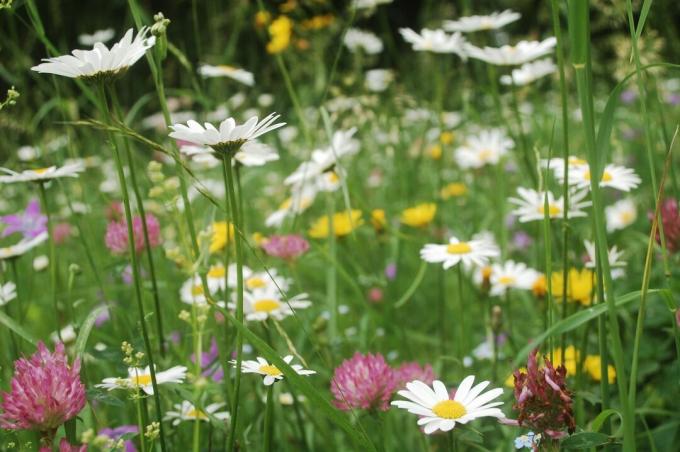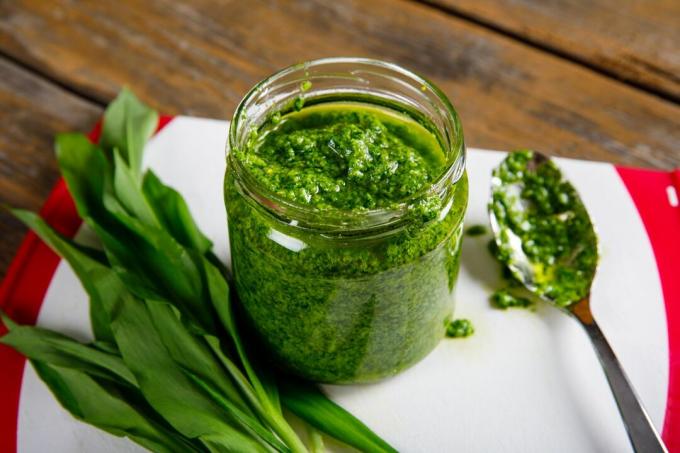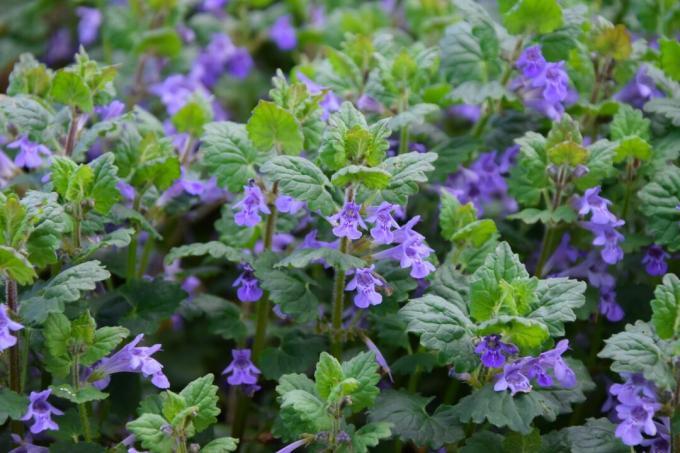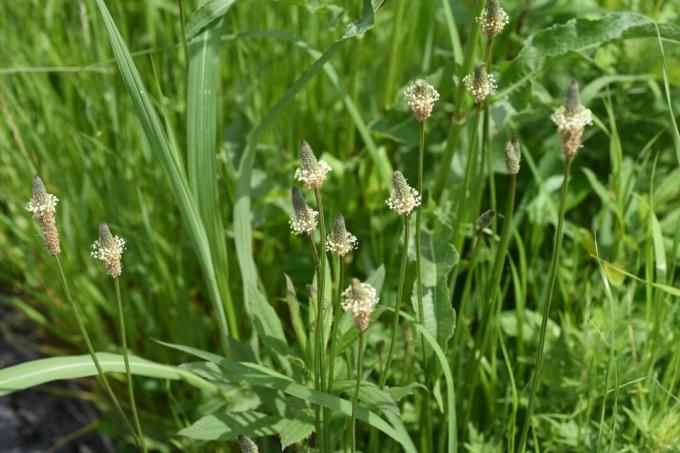They are easy to care for, beautiful, tasty and can have a soothing effect on a wide variety of ailments: We are of course talking about our native wild herbs.

Many wild herbs are certainly already growing in your garden, others can be found along the way. With the numerous aromas and possible uses, targeted cultivation is also worthwhile. All wild herbs are also valuable for our animal world, especially for insects.
contents
- What is meant by wild herbs?
-
List of native wild herbs
- 1. wild garlic
- 2. borage
- 3. nettle
- 4. daisy
- 5. Groundman
- 6. goutweed
- 7. chamomile
- 8. garlic mustard
- 9. cornflower
- 10. dandelion
- 11. red clover
- 12. yarrow
- 13. buckhorn
- 14. Chickweed
- 15. wild carrot
What is meant by wild herbs?
Wild herbs are wild-growing, herbaceous plants that, unlike ornamental plants, are not the result of human cultivation. Weed is also a positive term for weeds or weeds. Due to centuries of adaptation, wild herbs are important food sources for our insects. This mutual adaptation of plants and insects is called coevolution. Native insects find the flowers of many new ornamental plants difficult to use because they are the wrong shape, size, or have an unattractive scent. Many wild herbs are excellent for use in the kitchen and can be used as medicinal plants.

List of native wild herbs
Of the approximately 10,000 different plant species in Germany, around 3,500 are flowering plants. They also include our native wild herbs, some of which are easy to find along the way, but are often overlooked.
Tip: Some of the wild herbs listed are annual. This means that they do not simply sprout again, but must be propagated by seeds. If you harvest the flowers or fruit, you should sow the plants again next year. If the flowers remain on the plant, the wild herbs usually multiply by self-sowing.
1. wild garlic
One of the best-known domestic wild herbs is the wild garlic (Allium ursinum), which exudes an intense scent of garlic in spring. The young leaves of the perennial, herbaceous plant can be eaten and processed into pesto, for example. Its ingredients are said to be beneficial for digestive problems. Wild garlic is harvested from March, even before it flowers in April or May. It flowers white and can also be planted in the garden in a shady and moist spot. Wild garlic should not be confused with the poisonous lily of the valley (Convallaria malaris), which has very similar looking leaves.

2. borage
The leaves of borage (Borago officinalis) taste like cucumbers, which is why the plant is also called cucumber herb. Borage has star-shaped, steel-blue flowers that make it ideal as an ornamental plant. A damp, calcareous location in the sun is ideal for borage. In addition to the fresh leaves, you can also use the flowers in the kitchen and add them to desserts or salads, for example. As a medicinal herb, borage is mainly used for skin problems such as neurodermatitis or itching and is said to have an anti-inflammatory effect. Since borage is an annual, herbaceous plant, it must be sown again next year.

3. nettle
The size nettle (Urtica dioica) is one of the wild herbs that are generally unpopular. This is probably mainly due to the stinging hairs, which contain formic acid, among other things. This acid, in turn, is responsible for the burning sensation on the skin. Apart from that, the stinging nettle can be used in many ways in the kitchen and is also an important food plant for the caterpillars of native butterflies. Its flowers are inconspicuous, but can be roasted in a pan and mixed into salads as a crunchy ingredient. The leaves themselves taste delicious when fried or can be used raw in smoothies and salads. Of course, nettle tea is particularly well-known as a diuretic medicine for cystitis. Half-shady and nitrogen-rich places are ideal for the stinging nettle. The stinging nettle is deeply rooted and forms runners via its rhizome, which is why it can spread quickly and widely.

4. daisy
Everyone knows the daisy (Bellis perennis), because it grows all by itself in almost every garden or park and flowers almost all year round. However, only a few people know that the flowers of the perennial, herbaceous plant can also be eaten and that the daisy was even used in medicine. Together with other wild herbs, the daisy spices up salads and herb quarks. Consuming the flowers has an appetite-stimulating and anti-inflammatory effect. Daisies are quite adaptable and quickly settle on their own where they find good enough growing conditions. So if the white flowers don't appear in your lawn by themselves, they probably can't be planted artificially due to unsuitable site conditions. You can then only try to optimize the soil in terms of moisture, nutrient content and light exposure - but this is a time-consuming undertaking on large lawns.

5. Groundman
Also common in many gardens is the Groundman (Glechoma hederacea). It has purple lipped flowers and grows creeping along the ground. It can therefore also be used wonderfully as a ground cover. The ground ivy is one of the early bloomers and shows its flowers as early as April. Semi-shady or shady locations with nutrient-rich and fresh, moist soil are preferred. The aroma of ground ivy is slightly pungent, but also bitter and somewhat similar to mint. It is mainly used for wild herb salads and herb butter. It has an expectorant and diuretic effect and can be used for coughs and intestinal problems. The perennial and herbaceous plant forms numerous runners and spreads so quickly in the garden.

6. goutweed
Many wild herbs such as goutweed (Aegopodium podagraria) are not welcome in gardens, although they are very versatile. You can't go wrong with the old rule "Three, three, three - you're with Giersch" when harvesting make: Giersch has a triangular stem and three-part leaves, each of which is divided into three are. This is how ground elder can be distinguished from all other umbellifers. Many members of the plant family look very similar, but some are poisonous. Its white umbel flowers give every garden a natural atmosphere. Ground elder contains vitamins A and C as well as calcium, magnesium and many other ingredients and can be eaten simply on sandwiches or in soups and salads. Other plants grow from the rampant rhizome, so it is advisable to restrict the spread of herbaceous, perennial ground elder with a root barrier.
Tip: Ground elder is even available as an ornamental plant. The variety 'Variegata' comes with white-green variegated leaves therefore and is particularly decorative.

7. chamomile
It is best known for its pain-relieving effects. Tea is made from the chamomile blossoms. Of course we're talking about that real chamomile (Matricaria recutita). Like daisies and margarites, chamomile has white daisy flowers with a yellow centre. It smells pleasant and likes sunny, moderately humid and nutrient-rich locations. It is an annual herbaceous plant that needs to be sown every year. The flowers taste mildly sweet, the leaves subtly spicy. You can use them in wild herb salads, for example.

8. garlic mustard
Another representative of the native wild herbs is the garlic mustard (Allaria petiolata), which smells of garlic like wild garlic. However, the taste is less pronounced. The garlic mustard likes it in partial shade and slightly damp and can be found in many sparse deciduous forests. There, the biennial to perennial, herbaceous plant usually spreads strongly along the wayside. The cruciferous plant forms small white flowers between April and August. If you want to plant the garlic mustard, you should note that it is a cold germinator acts. The roots and seeds are also edible, although a mustard-like cream can be prepared from the latter with vinegar and salt.

9. cornflower
The annual cornflower (Cyanus segetum) convinces more with its appearance than with its taste. The flowers are edible, but not particularly flavorful. They are often used to decorate food. The cornflower used to grow in the middle of the grain field, but today it is rarely found in the agricultural landscape. The annual plant prefers sunny, humus-rich, well-drained locations and should not be sown on particularly nutrient-rich soil.

10. dandelion
Similar to the daisy, there is also the common one dandelion (Taraxacum officinale sect. ruderalia) in many gardens and on lawns in parks. It is immediately recognizable by its yellow flower and characteristic leaves. After the flowers have faded, the well-known dandelion develops. The herbaceous plant is perennial and drives out again from the rosette of leaves. There are many different types of plants that are popularly referred to as dandelions, but some of them belong to completely different genera. For example, dandelion honey can be made from dandelion, which does not require honeycomb from bees.

11. red clover
An important representative of local herbs is red clover (Trifolium pratense). It flowers more violet than red and with its spherical flower heads is a beautiful splash of color in every meadow. Clover is one of the so-called legumes and can fix nitrogen with the help of nitrogen-fixing bacteria. Red clover can also grow on nitrogen-poor soils or be used to enrich poor substrates with nitrogen again. It is a herbaceous annual to biennial plant. In the garden, red clover grows in sunny or partially shaded, slightly damp places. The young red clover seedlings taste slightly nutty and are valued for their high vitamin content. But the leaves and flowers of mature plants are also edible and help with diarrhea and menstrual cramps.

12. yarrow
If you suffer from digestive problems, you can also choose from the large selection of wild herbs yarrow (Achillea millefolium) to grab. It grows in almost every meadow and can be recognized by its finely feathered leaves, which also gave it the name thousand-leaf. It develops numerous white individual flowers arranged in a umbel. The yarrow prefers dry locations with high sun exposure and many nutrients in the soil. Foothills are formed over the rhizome, so that the herbaceous, perennial plant can spread quickly. The flowers can be used to make syrup or use the young leaves in salads. However, they are not particularly aromatic and taste slightly bitter. The parts of the plant above ground can be brewed as a tea and support digestion.

13. buckhorn
With its inconspicuous blossom, when it comes to wild herbs, the buckhorn (Plantago lanceolata) not directly to mind. It often grows along the wayside, which is probably where it got its name from, is herbaceous and sprout again for several years in a row. Its elongated, pointed leaves contain expectorant and anti-inflammatory substances, which is why they are used as medicinal herbs. It can also be crushed and applied to mosquito bites to relieve itching. The young inflorescences can be fried well and taste nutty. You can easily plant buckhorn in moist and sunny locations in the garden.

14. Chickweed
Similar to the daisy, the common one blooms Chickweed (Stellaria media) mostly year-round and displays its star-like white flowers. When sowing, make sure you use nutrient-rich soil, whereby Chickweed tolerates both sun and shade. Chickweed is an annual plant and must be sown again. The plant, which tastes slightly like corn and peas, is best enjoyed fresh on a sandwich. Chickweed tea is also prepared from fresh leaves and drunk to relieve coughs, for example.

15. wild carrot
Many do not even know that today's carrot originally came from the wild carrot (Daucus carota) descends. When you crush the leaves, however, the carroty scent hits your nose straight away. The wild carrot feels best in a sunny location with well-drained, sandy soil. It also belongs to the umbelliferae and forms white flowers, which, like all wild herbs, are also enjoyed by insects. The roots of the plant can be used like a carrot, while the leaves and seeds are used for seasoning. The wild carrot is biennial. The root should be harvested in the autumn of the first year, i.e. in the year of sowing. The flower only forms in the second year and is then unfortunately prevented.

Although you can do a lot for the world of insects with local wild herbs, there are also plants that are especially suitable for butterflies. We put the 10 most butterfly-friendly plants in front.
...and receive concentrated plant knowledge and inspiration directly in your e-mail inbox every Sunday!
